What Is Landscaping: A Comprehensive Guide
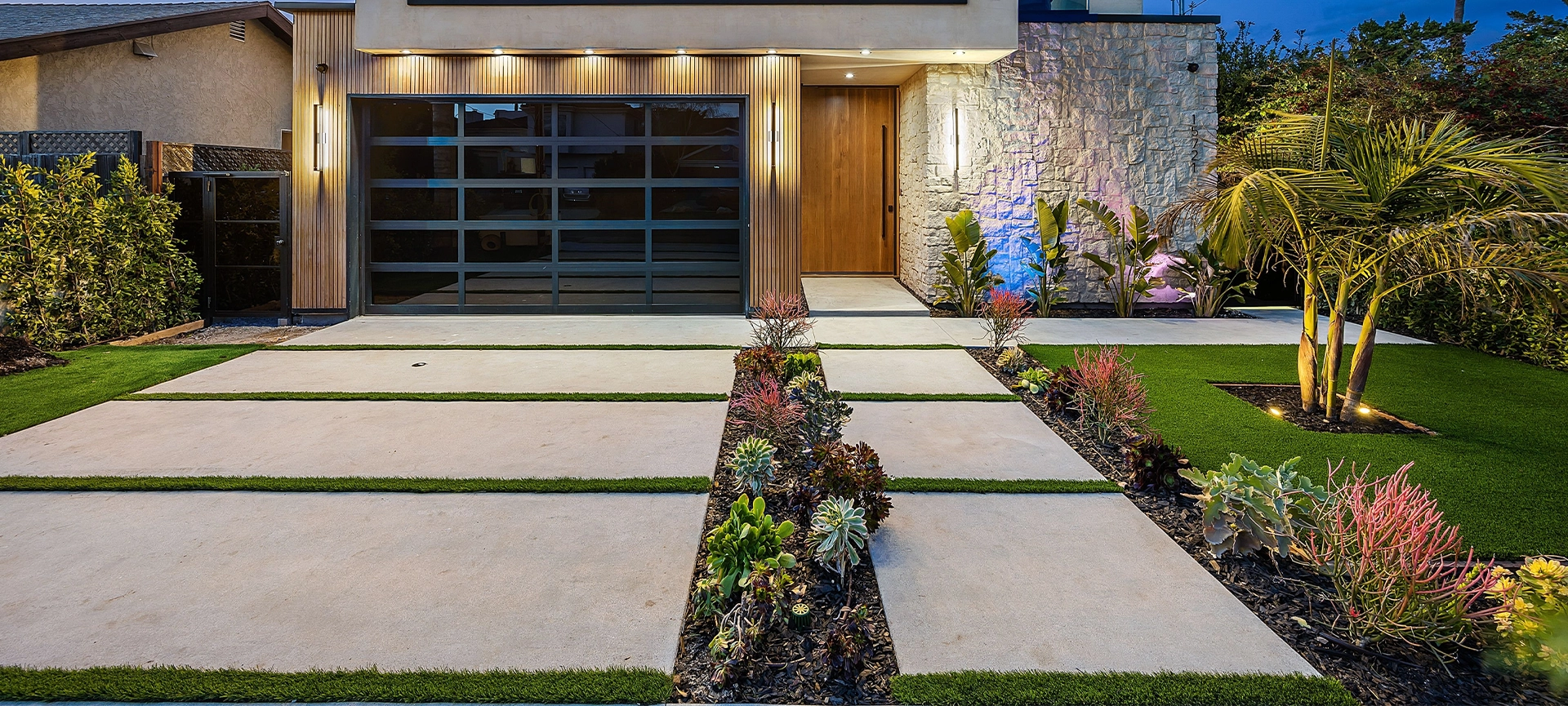
Everything You Need to Know About Landscaping in Canada
Landscaping is much more than adding a few shrubs or laying down sod — it’s the art and science of transforming outdoor spaces by modifying the visible features of land, such as terrain, plants, and structures, into functional, beautiful, visually appealing, and sustainable environments. From residential backyards in the GTA to large commercial plazas, good landscaping balances design, construction, and maintenance to create spaces that enhance property value and quality of life.
What is Landscaping?
Landscaping refers to the process of planning, designing, constructing, and maintaining outdoor environments. It includes both softscape (living elements like plants, lawns, and trees) and hardscape (non-living features like patios, walkways, decks, and retaining walls). Landscaping integrates different elements such as plants, terrain, and structures to create a harmonious design. Gardening, on the other hand, focuses specifically on cultivating and caring for plants, flowers, and vegetables, and is considered a key aspect within the broader scope of landscaping.
In Canada, landscaping is heavily influenced by our four distinct seasons — meaning every successful design must account for freezing winters, humid summers, and the transitional challenges of spring and fall.
Whether you’re creating a backyard retreat or designing the grounds for a commercial property, landscaping brings structure, harmony, and function to outdoor living.
Quick Facts About Landscaping in Canada
- The Canadian landscaping industry contributes over $10 billion annually to the national economy.
- A well-designed landscape can lead to increased property value by up to 15%, and a well-crafted landscape can increase the value of your property by up to 20%.
- Proper landscaping can reduce energy costs by up to 25% by providing natural shading and windbreaks, which lower both cooling and heating expenses.
- In Ontario, native plant landscaping has become one of the fastest-growing trends for sustainability.
- Strategic landscaping can help homeowners and businesses reduce energy costs by improving energy efficiency and lowering utility bills.
The Core Elements of Landscaping
Landscaping is a blend of design, construction, and maintenance. Each stage involves distinct skills and techniques that come together to create cohesive outdoor environments. A well-maintained landscape not only enhances the beauty and improves the overall appearance of outdoor spaces, but also improves the functionality and value of outdoor spaces.
1. Landscape Design
Landscape design is the blueprint for everything that follows. It starts with a thorough site assessment — examining soil type, soil conditions, drainage, sunlight exposure, existing vegetation, topography, and terrain.
A professional designer or landscape architect creates a plan that balances:
- Aesthetics: How the space will look and feel.
- Functionality: How it will be used (e.g., entertaining, relaxation, play, curb appeal).
- Sustainability: How it will perform over time, with minimal environmental impact.
Elements often incorporated into design plans include:
- Garden beds and plant layouts — garden beds are designated areas for growing plants such as flowers, vegetables, and herbs
- Walkways, patios, and decks
- Lighting design
- Irrigation and drainage systems
- Focal points (e.g., water features, fire pits, pergolas)
At Green Side Up Contracting, landscape design is always customized to the property and homeowner’s lifestyle — ensuring form and function meet seamlessly.
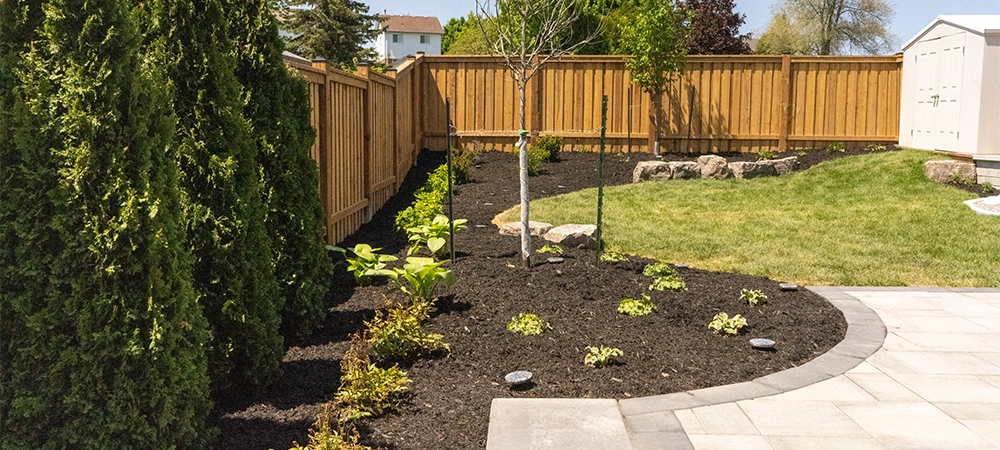
2. Hardscaping
Hardscaping includes all non-living, structural components of a landscape. It provides form, durability, and accessibility to your outdoor space. Hardscaping also refers to the use of non-living elements like rocks and wood to create decorative features in landscaping.
Common hardscape features include:
- Interlocking stone driveways and patios
- Retaining walls for sloped properties
- Decks and gazebos
- Outdoor kitchens and fire pits
- Pathways and borders that connect and separate different areas within a landscape, enhancing both function and visual appeal
- Steps, stairways, and landings
- Water features like fountains and ponds
A well-planned hardscape defines zones within a yard, improves usability, and sets the foundation for the softscape to thrive.
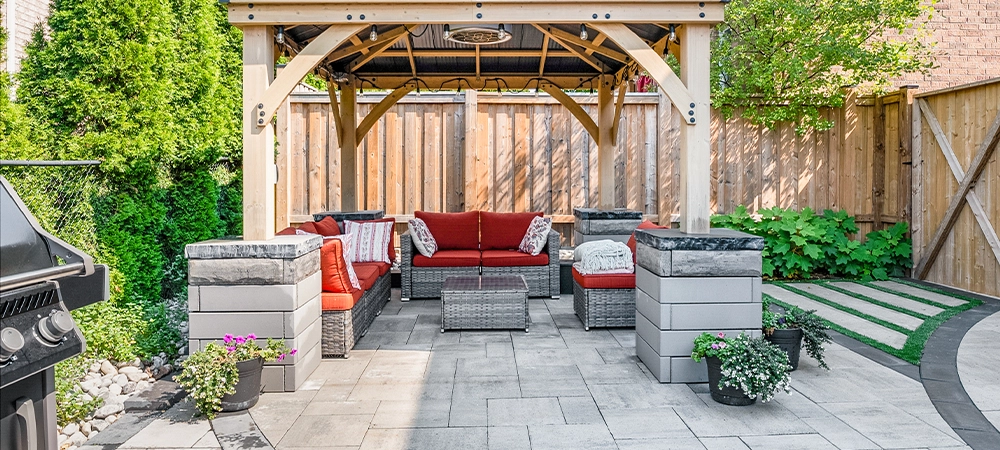
3. Softscaping
Softscaping adds life and colour through vegetation. It’s where texture, movement, and seasonal variety come into play. Common softscape elements include trees, shrubs, flowers, lawns (typically created with grass), vertical gardens, and garden beds.
Softscape components include:
- Trees, shrubs, and hedges
- Flowering plants and perennials
- Sod installation or seeding (primarily with grass for lawns)
- Ground covers and ornamental grasses
- Garden beds and mulch layers
Lawn care, including fertilization, aeration, and weed control, is essential for maintaining healthy and attractive lawns as part of a comprehensive landscaping plan.
Softscape decisions should always consider local climate, soil type, and maintenance preferences. In Southern Ontario, for instance, perennials like hostas, hydrangeas, and ornamental grasses are popular for their resilience and visual appeal.
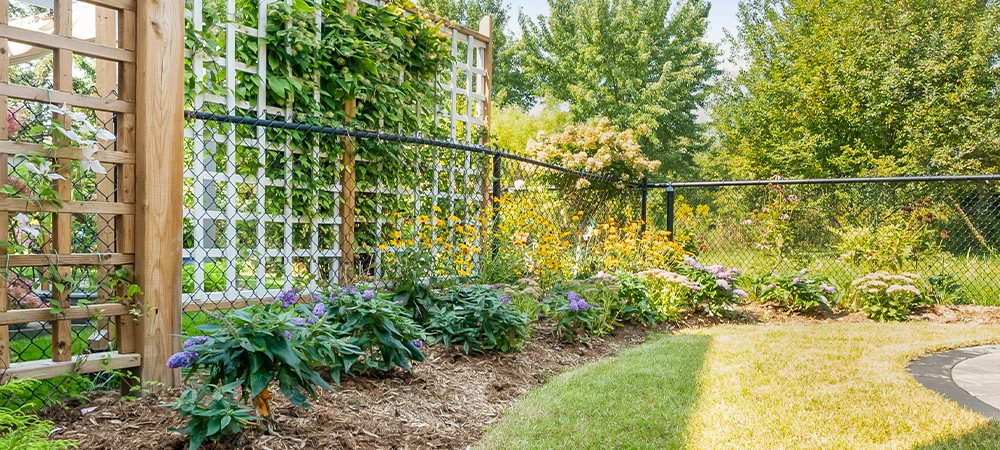
4. Irrigation and Drainage
No landscape can thrive without proper water management. Canadian weather brings extremes — from summer droughts to spring floods — making efficient irrigation and drainage systems essential.
Key systems include:
- Drip irrigation for water efficiency
- Sprinkler systems with smart timers
- French drains and swales for runoff control
- Rain gardens for natural filtration
Efficient irrigation and drought-resistant landscaping help conserve water, especially in regions prone to drought. These practices also conserve natural resources by reducing water and energy consumption.
Proper drainage protects hardscapes from erosion and prevents soggy lawns or plant root rot.
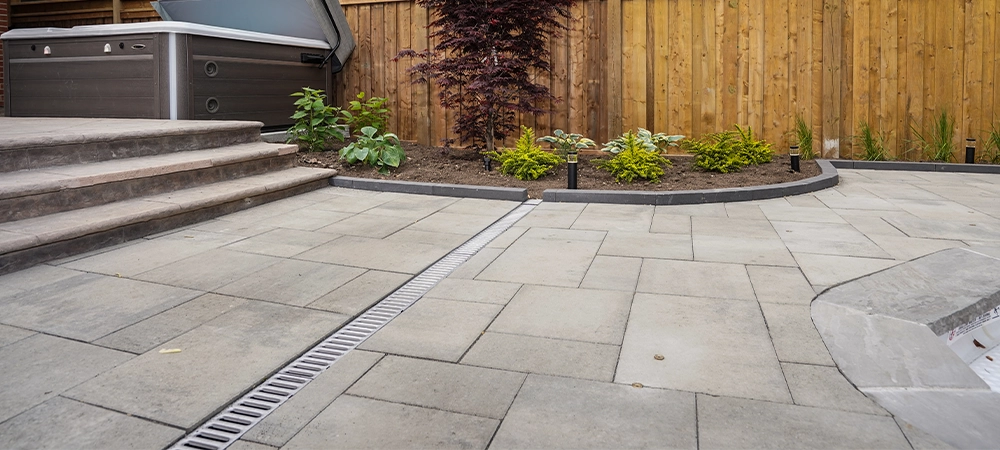
5. Landscape Lighting
Lighting extends usability and safety into the night. A good lighting design highlights architectural and landscape features while guiding movement.
Common lighting applications include:
- Pathway and stair lighting
- Uplighting trees or facades
- Deck and patio accent lighting
- Security and motion-sensor lighting
Modern systems often use energy-efficient LED fixtures and smart controls.
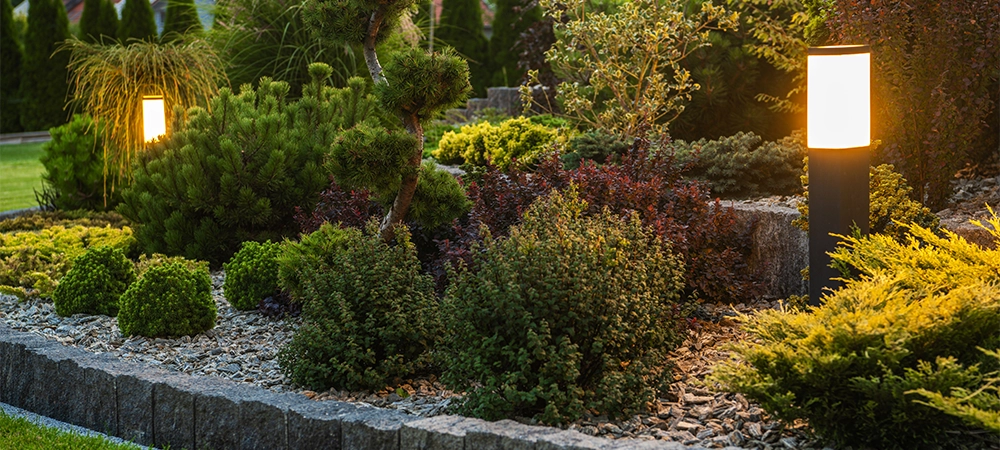
6. Grading and Site Preparation
Grading ensures proper water flow and establishes the foundation for everything else. Without it, even the most beautiful landscape can fail due to poor drainage or structural shifting.
This phase involves:
- Land clearing and excavation
- Slope adjustments
- Soil compaction or amendment
- Retaining wall construction for elevation changes
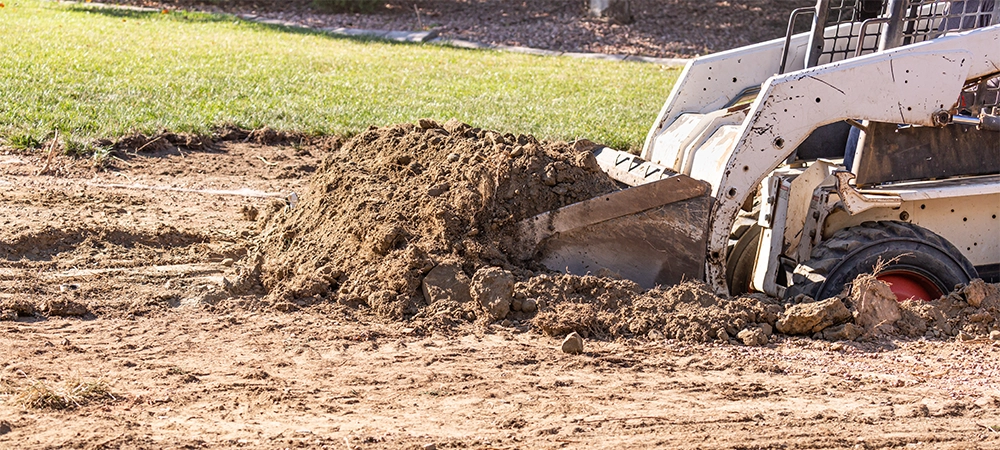
7. Maintenance and Seasonal Care
Landscapes evolve over time. Regular maintenance is essential to keep them healthy, clean, and attractive through all four seasons.
Services typically include:
- Lawn mowing and edging
- Fertilization and aeration
- Tree and shrub pruning
- Weed control
- Seasonal clean-ups
- Winter snow management for commercial sites
Green Side Up Contracting offers year-round maintenance programs tailored to both residential and commercial clients across the GTA, ensuring every property stays pristine in every season. A well-maintained landscape can also help reduce stress by providing a peaceful and orderly outdoor environment.
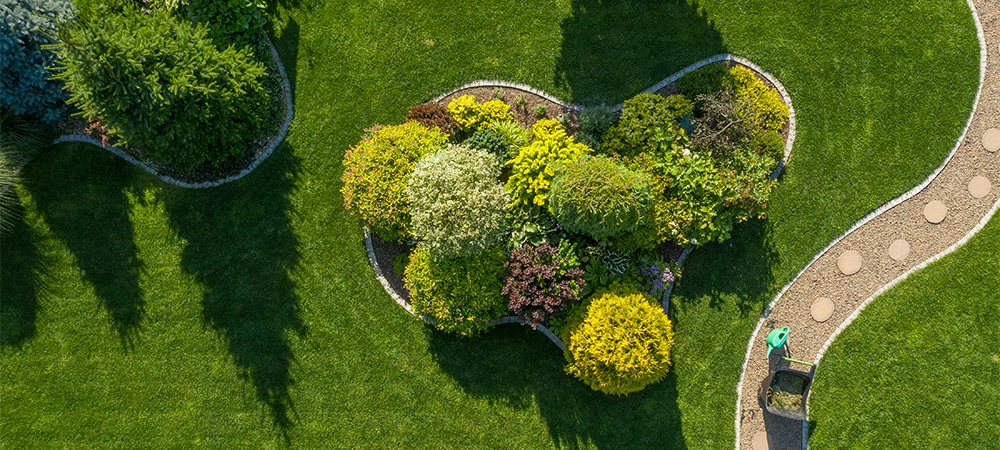
Residential & Commercial Landscaping
Residential Landscaping
Residential landscaping focuses on creating functional, beautiful, and livable spaces around private homes. Projects range from small front-yard makeovers to complete backyard transformations.
Popular residential features:
- Interlocking patios and walkways
- Composite or wood decks
- Gardens and plant beds
- Outdoor kitchens and fire features
- Landscape lighting for ambiance
- Planting trees to improve air quality, provide shade, and enhance the beauty of the property
Every home landscape should reflect the homeowner’s personality and lifestyle — whether it’s a low-maintenance modern garden or a lush, family-friendly yard. Attractive residential landscaping can also appeal to potential buyers and increase resale value.
Commercial Landscaping
Commercial landscaping applies the same design principles on a larger scale, with a stronger focus on durability, safety, and maintenance efficiency.
It includes properties such as:
- Office complexes and business parks
- Retail plazas and shopping centres
- Multi-unit residential developments
- Public spaces and schools
Key objectives include:
- Enhancing curb appeal to attract visitors or tenants
- Meeting accessibility and safety standards
- Reducing maintenance costs through smart design and irrigation
At Green Side Up Contracting, our commercial landscaping projects are designed to handle high traffic while maintaining a professional, polished appearance year-round. For commercial properties, investing in professional landscaping services by hiring a professional landscaper ensures expert design, installation, and ongoing maintenance, maximizing both visual impact and long-term value.
Related Article: Why is landscaping important for your business?
The Landscaping Process
Step 1: Consultation and Design
The process begins with a site visit, where the designer assesses existing conditions, discusses goals, and creates an initial concept or 3D rendering.
Step 2: Quotation and Planning
Once the design is finalized, a detailed estimate outlines costs for materials, labour, and any additional features like lighting or irrigation. The overall cost of a landscaping project depends on factors such as yard size, design complexity, and plant selection.
Step 3: Site Preparation
This includes excavation, grading, and setting up base materials for hardscaping.
Step 4: Construction and Planting
Hardscape elements are built first, followed by planting and finishing details such as mulch, edging, and lighting.
Step 5: Final Walkthrough and Maintenance
After completion, the contractor reviews maintenance tips and schedules follow-up visits to ensure everything settles properly.
Professional Landscaping vs. DIY
| Aspect | Professional Landscaping | DIY Landscaping |
| Design Expertise | Tailored design based on site conditions and lifestyle | May lack balance or long-term planning |
| Time Investment | Completed efficiently by trained crews | Can take weeks or months of personal labour |
| Tools & Equipment | Access to commercial-grade tools, materials, and machinery | Limited to homeowner tools |
| Quality & Longevity | Professionally installed with warranties and proper grading | Often needs rework or correction later |
| Cost Efficiency | Higher upfront cost, lower maintenance and repair costs long-term | Lower upfront cost, but higher long-term upkeep |
| Safety | Work performed to code, with proper drainage and load-bearing standards | Risk of injury or costly mistakes |
DIY can work for small-scale projects like planting beds or garden edging. However, professional landscaping delivers long-term value, durability, and resale appeal — especially for larger or structural projects.
Related Article: How to find A Landscape Contractor for Your Condo Property
The Benefits of Professional Landscaping
- Increases property value: Up to 15% in resale appeal. Professional landscaping can significantly improve the aesthetics and overall quality of outdoor spaces.
- Creates outdoor living space: Expands usable square footage.
- Boosts energy efficiency: Strategic trees and hardscape help regulate temperature.
- Enhances curb appeal: A polished exterior reflects pride of ownership.
- Reduces maintenance stress: Ongoing care plans save time and effort.
- Improves environmental impact: Sustainable practices and native planting promote biodiversity. Professional landscaping can significantly improve the visual appeal and well-being benefits of your property.
- Conceals utilities and clutter: Strategic plantings, privacy screens, and custom enclosures hide pool equipment, bins, meters, and AC units—clean look, easy service access.
Related Article: Benefits of Hiring a Landscape Designer
Landscaping Styles and Trends in Canada
Here are some of the most popular landscaping ideas and trends in Canada to inspire your outdoor space:
- Modern Minimalist Landscaping – Clean lines, structured plantings, neutral palettes, composite decking.
- Naturalistic Landscaping – Native plants, organic shapes, stone paths, and pollinator-friendly gardens.
- Cottage Garden Style – Colourful perennials, layered textures, and vintage stone borders.
- Contemporary Urban Gardens – Compact layouts, rooftop greenery, planters, and lighting.
- Sustainable Landscaping – Permeable paving, drought-tolerant plants, and rainwater harvesting.
Each style can be customized to reflect personal taste while respecting environmental conditions.
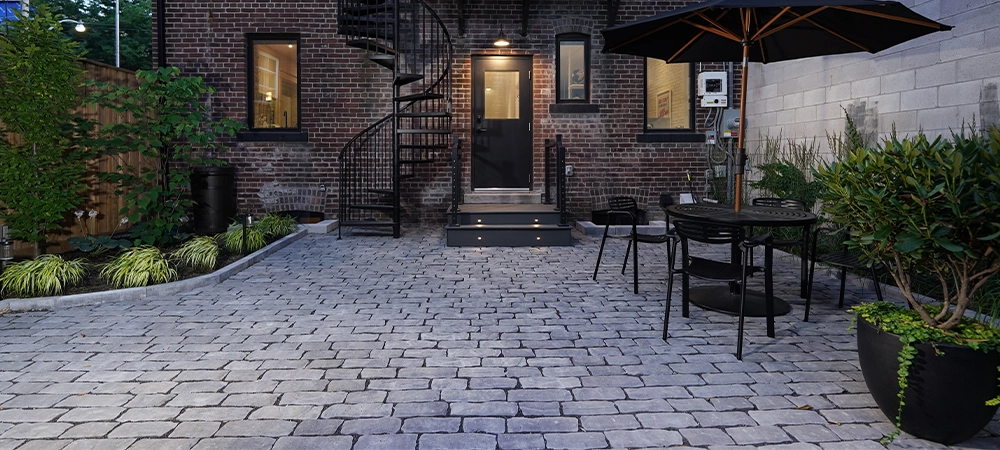
Environmental and Sustainable Landscaping
Modern landscaping goes beyond looks — it’s about balance with nature. Sustainable landscaping practices help reduce water use, chemical runoff, and waste while creating healthier ecosystems. Native landscaping, which uses local plants adapted to the environment, is a key strategy for sustainability.
Key techniques:
- Using native and drought-resistant plants
- Installing permeable pavers to reduce runoff
- Adding rain gardens and bioswales
- Composting and organic fertilization
- Reducing turf areas in favour of naturalized zones
- Conserving natural resources through sustainable landscaping practices
These eco-conscious methods save money on maintenance and help properties thrive with less input. Native landscaping also supports local wildlife and contributes to ecological conservation.
Real-World Example: A Backyard Transformation
At Green Side Up Contracting, we’ve had the privilege of working on a wide variety of landscaping projects that showcase different designs and features tailored to our clients’ unique needs. From creating inviting patios and sturdy retaining walls to integrating elegant lighting and lush plantings, each project reflects our commitment to thoughtful landscape design and professional execution. These examples highlight how we transform outdoor spaces into functional, beautiful, and welcoming environments that enhance property value and provide enjoyable outdoor living spaces customized to different lifestyles and preferences.
How Landscaping Enhances Property Value
Landscaping doesn’t just improve appearance — it’s a strategic investment.
- Curb Appeal: First impressions matter. Well-kept lawns and entryways attract buyers.
- Functionality: Patios and decks expand living space.
- Environmental Benefits: Trees and plants improve air quality and reduce runoff.
- Maintenance Impression: A manicured landscape signals a well-maintained home overall.
According to the Canadian Nursery Landscape Association, professional landscaping can increase a property’s resale value by up to 15%, depending on scope and location.
Common Mistakes in Landscaping
- Ignoring proper grading and drainage
- Choosing non-native or invasive species
- Overcrowding plants without considering their mature size
- Skipping soil testing and amendment
- Forgetting irrigation and maintenance needs
- Focusing on trends instead of longevity
Hiring a qualified team helps avoid these pitfalls from the start.
Best Time to Start Your Landscaping Project
Timing is crucial for a successful landscaping project, especially in Canada, where the climate varies significantly throughout the year. The best time to begin your landscaping largely depends on the type of work you plan to do and the local seasonal conditions.
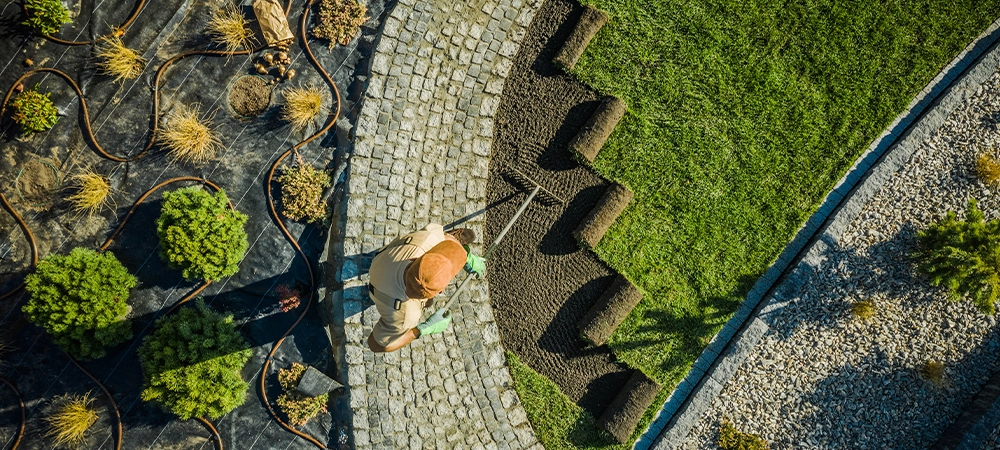
Spring and Early Summer
Spring, particularly from late April to June, is often the ideal time to start planting trees, shrubs, and perennials. The soil is warming up, and the risk of frost diminishes, allowing plants to establish strong root systems before the heat of summer. Early summer is also suitable for installing hardscaping features like patios and walkways, as the weather is generally dry and stable.
Fall
Fall is another excellent season for landscaping projects, especially for planting trees and shrubs. Cooler temperatures and increased rainfall help reduce transplant shock and encourage root growth. Fall planting gives vegetation a head start for the following spring. It’s also a good time for soil preparation and laying sod, as the ground remains warm enough to support growth.
Summer
While summer can be a busy time for landscaping, especially maintenance and irrigation setup, planting during the hottest months requires extra care. Watering needs increase, and heat stress can affect newly planted vegetation. Hardscaping and construction work can proceed, but it’s essential to plan for adequate hydration and shade for plants.
Winter
In Canada, winter is generally not suitable for most landscaping installations due to frozen ground and snow cover. However, it’s a perfect time for planning landscaping, design consultations, and ordering materials in preparation for spring. Some indoor work, such as prefabricating elements or designing irrigation systems, can also be done during this period.
Consider Your Specific Goals
Your project’s goals may influence timing as well. For example, if you want to create a backyard retreat ready for summer entertaining, starting in early spring ensures ample time for plants to mature and hardscape to settle. For commercial properties, scheduling projects during off-peak business seasons can minimize disruption.
At Green Side Up Contracting, we advise clients to plan landscaping projects around these seasonal windows to maximize plant health, project efficiency, and overall success.
Frequently Asked Questions
1. How much does professional landscaping cost in Ontario?
Most projects range from $5,000 to $100,000+, depending on size, materials, and complexity. A simple front-yard makeover may start around $10,000, while a complete outdoor living build costs significantly more.
2. When is the best time to start a landscaping project in Canada?
Spring and early summer are ideal for planting and construction. Fall is also suitable for planting perennials and trees, allowing roots to establish before winter.
3. How long does landscaping take?
Small projects may take 1–2 weeks. Large-scale builds involving grading, stonework, and lighting may take 4–8 weeks, depending on weather and material availability.
4. What maintenance is required after installation?
Regular watering, fertilization, pruning, and seasonal cleanups are essential. Many homeowners choose annual maintenance contracts for worry-free upkeep.
5. What are the benefits of a live fence or hedge for privacy?
Live fences or hedges are excellent natural barriers that provide privacy, reduce noise, and add lush greenery to your outdoor space. They can be customized with native shrubs or trees, offering both aesthetic appeal and environmental benefits such as supporting local wildlife.
6. How do I choose the right landscaping company?
Look for licensed, insured contractors with a strong local portfolio and customer reviews. Green Side Up Contracting, for instance, is an award-winning GTA company known for its craftsmanship and client service.
7. Do I need a permit for landscaping?
Most residential projects don’t require permits unless they alter grading, add structures, or affect drainage. Your contractor will guide you through any required approvals.
8. Is winter landscaping possible in Canada?
While full builds aren’t practical in frozen conditions, design planning, quoting, and indoor prefabrication can be done during winter to prepare for early spring execution.
Final Thoughts
Landscaping is the bridge between nature and construction — transforming empty yards into living environments that enrich daily life. Most landscaping projects follow a multi-step process, from initial design to long-term care. From conceptual design and material selection to long-term maintenance, every step shapes how your outdoor space looks, feels, and functions.
Whether you’re dreaming of a modern interlock patio, a naturalized garden, or a full outdoor living space, professional landscaping services ensure your investment thrives for decades.
At Green Side Up Contracting, we bring over two decades of experience designing and building premium landscapes across Toronto and the GTA. Our team combines craftsmanship, sustainability, and customer care to turn every property into a reflection of quality — from the ground up. Contact us today to start your landscaping project.
